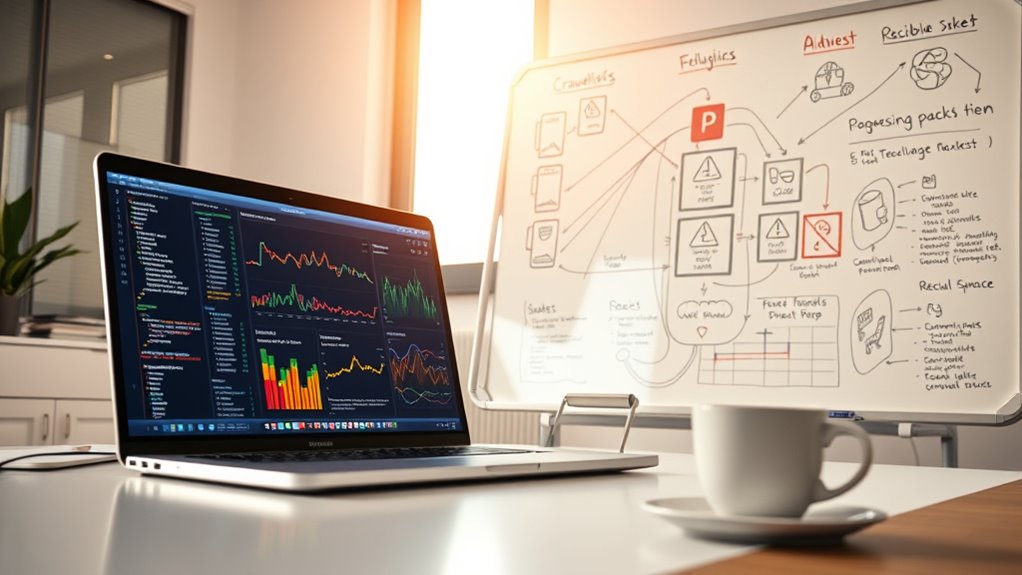To optimize your crawl budget for a large website, focus on analyzing your current crawl patterns and identifying bottlenecks like slow server responses or duplicate content. Prioritize key pages through improved internal linking and clear site hierarchy, while removing unnecessary pages. Implement technical optimizations such as faster server responses and streamlined URLs. Regularly monitor crawl data and adjust your strategies accordingly. Continuing will reveal more tactics to maximize your site’s crawl efficiency and search visibility.
Key Takeaways
- Analyze crawl patterns and identify bottlenecks like slow responses or redirects to improve efficiency.
- Prioritize high-value pages through internal linking and content updates to ensure they receive adequate crawl attention.
- Streamline site architecture and URL structures to facilitate faster crawling and better indexing.
- Regularly monitor crawl rate data using server logs and Search Console insights to detect issues and adjust crawl strategies.
- Remove duplicate content and refine sitemaps to prevent wasteful crawling and optimize crawl budget allocation.
Understanding Crawl Budget and Its Significance for Large Sites

Understanding crawl budget is essential for managing large websites effectively. Your crawl budget determines how often search engines visit and index your pages, impacting your site’s visibility. A well-optimized site structure helps search engines navigate efficiently, ensuring important pages get crawled regularly. Additionally, link authority plays a vital role; pages with higher link authority are more likely to be crawled frequently because they’re deemed more valuable. By organizing your site with clear hierarchies and internal links, you can direct crawlers to priority content while conserving crawl resources. This strategic approach prevents search engines from wasting time on irrelevant pages, ensuring your most important content gets indexed quickly. Incorporating sound healing science principles into your technical SEO strategies can help enhance your site’s overall health and ranking potential. Furthermore, understanding content indexing helps you prioritize pages for better visibility. Mastering crawl budget management ultimately boosts your site’s SEO performance and search presence, especially when considering how search engine algorithms evaluate site structure and content quality. Regularly auditing your site for duplicate content and fixing issues ensures optimal use of your crawl budget and better indexing.
Analyzing Your Current Crawl Patterns and Identifying Bottlenecks

Once you’ve established a solid understanding of your site’s crawl budget, the next step is to analyze how search engines are actually crawling your pages. You need to examine your crawl pattern to see which pages are visited most often and identify potential bottlenecks. Recognizing these bottlenecks helps you pinpoint issues like slow server responses or unnecessary redirects that hinder efficient crawling. Additionally, implementing ECU remapping can optimize server responses and reduce crawl delays. Monitoring crawl rate patterns can also reveal areas where your site may be over- or under-crawled, allowing you to refine your crawl budget effectively. Exploring tuning modifications can further enhance your site’s performance and crawling efficiency. Regularly reviewing your crawl data can uncover crawl anomalies that may be impacting your overall SEO performance. Being attentive to crawl frequency fluctuations ensures that your website remains optimized for search engine bots.
Strategies to Prioritize and Streamline Important Pages

To effectively optimize your crawl budget, you need to prioritize your most important pages so search engines focus their resources there. Start by improving internal linking to guide crawlers toward high-value content, ensuring these pages get crawled more often. Remove or consolidate duplicate content to prevent wasteful crawling and clarify your site’s structure. Additionally, create a clear hierarchy that highlights key pages, making it easier for search engines to identify what matters most. Consider these strategies:
- Use internal links strategically to elevate priority pages
- Eliminate duplicate content to streamline crawl focus
- Maintain a logical site structure emphasizing key pages
- Regularly update and refresh important content for crawlers
- Recognize that individual responses to site changes can vary based on personality and age, so monitor your site’s performance and adjust your strategies accordingly. Incorporating website hours and operational timings can also help in planning content updates to match peak crawling times. Being aware of brand reputation and how it influences search engine priorities can further enhance your optimization efforts. For example, understanding factors influencing crawl frequency can help tailor your approach to different types of content. Additionally, paying attention to crawl budget limitations can help you identify and fix issues that hinder efficient crawling.
Implementing these tactics helps search engines efficiently allocate crawl resources to your most valuable pages.
Implementing Technical Optimizations to Enhance Crawl Efficiency

After prioritizing your most important pages through internal linking and site structure, the next step is to implement technical optimizations that boost crawl efficiency. Focus on improving indexation speed by optimizing your server response times—faster servers lead to quicker page loading and smoother crawling. Use the table below to visualize how different elements work together:
| Optimization Aspect | Impact |
|---|---|
| Minimize server response time | Faster crawl cycles |
| Streamline URL structures | Easier for crawlers to navigate |
| Remove duplicate content | Reduces unnecessary crawling |
| Self Watering Plant Pots | Innovative solutions that ensure consistent moisture, reducing the need for frequent site updates and minimizing crawling of unnecessary content. Additionally, optimizing website performance can further enhance crawl efficiency by ensuring all pages load swiftly and reliably. Improving your crawl budget management is essential for large websites to prevent resource wastage and ensure important pages are crawled efficiently. Proper site architecture facilitates better crawling and indexing by search engines. Enhancing your site’s content quality also encourages more efficient indexing by search engines. |
Monitoring and Adjusting Your Crawl Budget Over Time

Monitoring and adjusting your crawl budget is essential to maintaining ideal site performance. Regularly reviewing your site’s indexation and crawl frequency helps identify areas needing improvement. Keep an eye on your server logs and Google Search Console data to spot crawl issues or bottlenecks. Adjust your strategy based on this data to prevent overloading your server or wasting crawl resources. Focus on these key actions:
- Prioritize important pages for consistent crawling
- Reduce crawl rate for low-value or outdated content
- Fix crawling errors that hinder site indexation
- Use sitemap updates to guide search engines efficiently
- Remember that understanding your site’s content significance helps tailor your crawl strategy effectively. Being aware of your crawl budget management ensures you allocate resources wisely and maintain optimal indexing. Regularly updating your website structure can also improve crawl efficiency and prevent unnecessary crawling of irrelevant pages.
Frequently Asked Questions
How Does Crawl Budget Impact Website Ranking?
Your crawl budget influences your website ranking because it determines how often search engines visit your site. If search engines spend more time crawling high-quality pages that boost your site authority and content freshness, your rankings improve. However, inefficient crawling can waste budget on low-value pages, limiting visibility. Optimizing your crawl budget guarantees search engines focus on your best content, helping your site rank higher and stay relevant.
What Tools Are Best for Analyzing Crawl Data?
Imagine revealing the secrets of your site’s health—you’ll want the best tools for analyzing crawl data. A thorough site audit tool like Screaming Frog or Sitebulb helps you monitor crawl frequency and identify issues. These tools reveal how search engines explore your website, allowing you to optimize your crawl budget efficiently. With their insights, you can refine your strategy, ensuring your site stays healthy and ranks higher.
Can Increasing Server Capacity Improve Crawl Efficiency?
Increasing server capacity can improve crawl efficiency by enabling server scaling and providing a bandwidth boost. When your server can handle more requests simultaneously, search engines crawl your site more effectively without hitting errors or delays. This reduces crawl budget waste, ensuring important pages get indexed faster. So, by upgrading your server’s capacity, you help search engines access your content more smoothly, optimizing your overall site visibility and performance.
How Often Should Crawl Budget Strategies Be Reviewed?
You should review your crawl budget strategies regularly to guarantee optimal performance. Keep an eye on crawl frequency and monitor how your site changes over time. Budget reevaluation is essential whenever you update content, add new pages, or notice any indexing issues. By consistently evaluating these factors, you can adjust your approach, prevent overloading your server, and improve your website’s visibility in search engines.
What Are Common Mistakes in Crawl Budget Management?
Think of managing your crawl budget like watering a garden—you want to avoid overdoing it. Common mistakes include neglecting to reduce duplicate content, which wastes crawl resources, and setting crawl frequency too high or low, causing missed updates or wasted bandwidth. You might also overlook fixing broken links or updating outdated pages, leading crawlers astray. Keep a balance, monitor your site’s health, and refine your strategies to optimize your crawl budget effectively.
Conclusion
Just like Odysseus steering treacherous waters, mastering your crawl budget requires careful planning and continuous adjustment. By understanding your site’s crawl patterns and prioritizing key pages, you guarantee Google sails smoothly through your digital landscape. Keep monitoring and refining your strategies, so your website’s health remains legendary. With perseverance, you’ll turn the chaos of large sites into a well-oiled machine—your own hero’s journey to SEO greatness.









